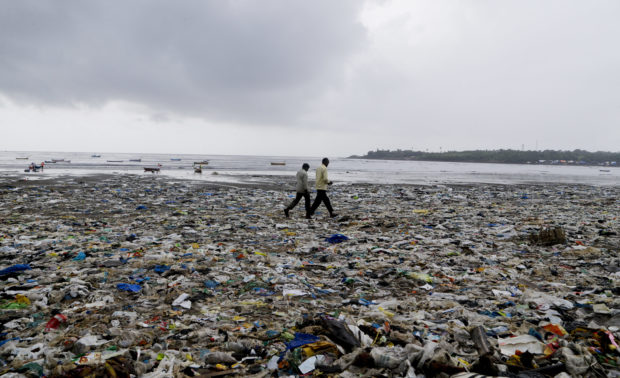
In this Aug. 19, 2017 photo, people walk past garbage at the Versova beach on the Arabian Sea coast in Mumbai, India. The 2.5-kilometer (approximately 1.5 miles) stretch of Mumbai’s Versova beach was littered with plastic water bottles, discarded plastic bags and containers, empty packets of chips, and more plastic wrappers. According to government estimates, each one of India’s 1.3 billion citizens generates roughly 0.2 to 0.6 kilograms (approximately 0.44 to 1.3 pounds) of waste each day. (AP Photo/Rajanish Kakade)
MUMBAI, India — Lawyer Afroz Shah moved to Mumbai with a dream of looking out at the wild, blue Arabian Sea. But what he saw was nauseating — waves churning with plastic shopping bags and empty chip packets, beaches covered so thick with soda bottles and snack wrappers he could no longer see the sand.
The coast off India’s financial capital, like so many other places across the South Asian nation, has become choked by garbage tossed without much thought by the millions of people who live there.
“I could have gone to the court. I could have complained” to municipal authorities, said Shah, 34. Instead, he decided to take action literally with his own two hands.
He and a neighbor near Mumbai’s Versova Beach pulled on glove and face masks and began picking rubbish out of the sand. Gradually, they were joined by other volunteers and sometimes tourists.
For over 98 weekends, they gathered more than 5 million kilograms (11 million pounds) of trash.
“This littering is done by us,” Shah said of his fellow Indian citizens. “I should pick it up.”
One environmental activist called India’s garbage problem a “ticking time bomb” that will ultimately bury the nation’s cities and towns unless its 1.3 billion people stop littering at will.
Chitra Mukherjee, of the New Delhi-based Chintan Environmental Research and Action Group, declared that India is “drowning in trash.”
Government estimated that each day, every Indian generates about 200 to 600 grams (7 ounces to 1.3 pounds) of garbage, which vast majority ending up tossed into the country’s forests, parks, streets and sidewalks, as well as rivers or surrounding oceans.
“The citizen has to realize that ‘this is my waste, nobody is going to take care of it but me’,” Mukherjee said.
In 2014, the government tried to raise awareness with a campaign called “Swacch Bharath Abhiyan,” or “Clean India Mission”. Prime Minister Narendra Modi even hammed it up for media photographers by posing with a broom.
But three years later, little has changed. People still carried their household trash in plastic bags to the edge of the water and tossed it out to sea, watching as it bobs away.
The slow progress means Shah and others continue leading small citizens’ movements to help. But not every effort has been successful.
A group called New Delhi Rising said it has been unable to find enough volunteers to handle the 15,500 tons of waste generated every day in the Indian capital.
New Delhi’s three landfills are already overflowing, noted the group’s founder, Nakul, who, like many in India, goes by only one name.
Even the swankiest neighborhoods often have garbage tucked into the corners between buildings or beneath park benches.
Some Delhi students volunteer regularly to help pick it up, but most of New Delhi Rising’s engagement has merely come from social media ‘likes’ and follows. Nakul hoped more residents will come out to help.
“It only takes two hours, it doesn’t take money,” he said. KGA

